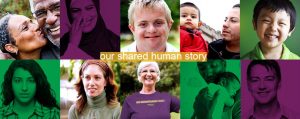Reframed Digital Campaign a Big Success for Illinois Partners
March 7, 2019 Our long-time National Reframing Initiative partner, Illinois Partners for Human Service, recently launched “Our Shared Human Story” (OSHS), a digital marketing campaign aimed at promoting the value of human services as well as raising awareness of Illinois Partners, a statewide coalition of over 800 human service organizations.
Our long-time National Reframing Initiative partner, Illinois Partners for Human Service, recently launched “Our Shared Human Story” (OSHS), a digital marketing campaign aimed at promoting the value of human services as well as raising awareness of Illinois Partners, a statewide coalition of over 800 human service organizations.
Illinois Partners worked diligently to integrate the FrameWorks Institute research findings into the OSHS campaign. We recently spoke with Illinois Partners about the campaign’s success and the significant role reframing played in its strategic development.
“We have fully embraced reframing as an organization and in the story that we’re telling about human services,” said Judith Gethner, Illinois Partners’ Executive Director. “We understand how the public views our sector and, more importantly, why. The research informed our approach, and now reframing is one of the tools we use continuously to guide our communications strategies. The results of our awareness campaign speak volumes.”
OSHS intentionally uses reframing strategies to effectively communicate with the public. For instance, the campaign theme, “Our Shared Human Story,” emphasizes the idea that human services impact each of us, not just a select few. It also incorporates the Building Well-Being Narrative by invoking human potential (e.g., “fosters potential”), using the construction metaphor (e.g., “builds strong, thriving communities,” “weather life’s storms”) and showing how human services support everyone across the life cycle—children, young people, adults, older adults, people with disabilities, all of us. Just as important is what the campaign doesn’t do: it doesn’t offer data out of context, use jargon, or offer episodic stories about individuals that can be counter-productive.

The 2018 digital marketing campaign was Illinois Partners’ first foray into advertising and included banners on websites, video ads, and posts on Twitter, Facebook, and Instagram. They reframed the entire website, created a new dedicated Our Shared Human Story webpage, and featured the branding on the organization’s homepage—in preparation for the new campaign.
The results of the two-month campaign exceeded expectations and indicate that the messaging and digital ads engaged and resonated with the public:
- Website banner click-rates surpassed the industry average, leading to 4.3 million total impressions.
- Illinois Partners’ website experienced four times more total website traffic.
- OSHS was the number one most-visited page on the website, accounted for more than two-thirds of all page views, and had seven times more traffic than the homepage.
- On average, visitors spent two+ minutes on the OSHS page, indicating their desire to learn more about human services.
- Illinois Partners’ Facebook reach more than doubled during the campaign, and their Twitter reach nearly tripled.
Moreover, OSHS has been extraordinarily well-received by partners. To amplify the campaign, Illinois Partners is doing outreach to feature partners and soliciting stories and videos and other forms of participation from human service organizations. It also invites partners to use the website and language as a model for their own, which many have done. To have an even broader impact, it is Illinois Partners’ hope that other states will take notice of the campaign and replicate it.
While Illinois Partners began the campaign with animated digital ads focused on the importance of human services, such as opioid rehab and shelters, Gethner says they plan to grow and expand the campaign over the next year to incorporate different service areas, including mental health, early childhood development, and supports for older adults, among others.
“Shifting public perception isn’t easy and will take time, but we know that reframing has transformed our communications in a way that is exciting and strategic because it is supported by proven data,” Gethner added. “The story we’re telling in partnership with the National Assembly will improve understanding of human services; it’s inclusive and stresses how our sector impacts all of us.”
SPOTLIGHT: Implementation Guide – Module 2: Implementing the Frame
Once your organization is on board with reframing, Module 2: Implementing the Frame of the Building Well-Being Narrative Implementation Guide teaches you through practical strategies, examples, tools, and resources about incorporating FrameWorks’ recommendations and how to do a thorough review and revision of materials, including organizational, advocacy, and media/social media communications.
- Reframing Organizational Communications shows you how to apply the value of human potential, construction metaphor, and life cycle examples to the foundational content of your organization’s external communications, such as Mission and About Us statements.
- Reframing Advocacy Communications demonstrates how to use the Building Well-Being Narrative to help provide a clear understanding of the societal value and collective benefits of the full range of human service programs and policies through reframing communications, including policy platforms and agendas, as well as talking points and position statements.
- Reframing Media and Social Media teaches you how to intentionally and consistently reframe messaging through these channels to communicate with and educate your constituencies, build networks, and engage in policy advocacy.

